Military-technical cooperation between Western countries and China in the field of aviation and anti-aircraft missiles
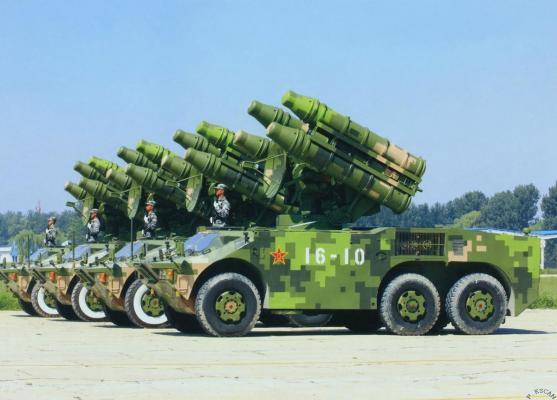
В stories there are many cases when relations between the closest allies became openly hostile within a short time interval. There are also many examples of how seemingly irreconcilable enemies become partners. A vivid example of this kind is China's relations with the USSR and the USA.
Thanks to the assistance provided by the Soviet Union, the Chinese Communists in 1950 established control over the entire continental part of the country. In the first decade after the founding of the PRC, our countries maintained very close economic, political and military ties, speaking as a united front in the international arena. Although relations between Moscow and Beijing began to cool after Stalin's death, China and the USSR worked together to counteract US aggression in Southeast Asia.
However, in the late 1960s, the contradictions between the former closest strategic allies escalated so much that it came to armed clashes on the Soviet-Chinese border.
Even before the end of the Vietnam War, the process of normalizing relations between China and the United States began. In July 1971, Henry Kissinger, Assistant to the President of the United States for National Security, visited Beijing on a secret voyage. During negotiations with Premier Zhou Enlai, a preliminary agreement was reached on an official visit to China by President Richard Nixon, which took place in February 1972. The parties agreed to establish diplomatic relations at the level of special envoys, which began work in May 1973. On January 1, 1979, the United States officially recognized the People's Republic of China, after which Deputy Premier of the State Council of the People's Republic of China Deng Xiaoping visited Washington, where he met with US President Jimmy Carter.
After Vietnam sent its troops into Cambodia at the end of 1978 and overthrew the Khmer Rouge government, in February 1979 China launched a special military operation against Vietnam. The conflict was fierce, but already at the end of March, most of the Chinese troops left Vietnamese territory. The withdrawal of the PLA troops from Vietnam occurred after the USSR delivered large batches of the latest weapons, the deployment of additional Soviet divisions in the areas bordering the PRC began, and the ships of the Soviet Navy headed for the Vietnamese coast. At that time, the Soviet Union had multiple superiority over China in nuclear weapons, which in many ways became a pacifying factor for Beijing.
The fighting in the northern regions of Vietnam, bordering China, demonstrated the low combat capability of the regular Chinese army. Although the personnel units of the PLA were mainly opposed by the Vietnamese border guards and militias, the Chinese, having met fierce resistance, despite their numerical superiority, could not solve all the tasks. The military-political leadership of the PRC, after analyzing the course of the armed conflict, came to the conclusion that it was necessary to radically modernize the armed forces and abandon the concept of a mass "people's army" proclaimed by Mao Zedong.
If in the 1950s and, to some extent, in the 1960s, the USSR transferred modern technically sophisticated weapons to the PRC and assisted in establishing its licensed production, then in the 1970s, Chinese industry, design bureaus and research institutes, which experienced significant the difficulties caused by the consequences of the “cultural revolution” turned out to be unable to independently create and produce modern models of equipment and weapons.
The rapprochement between the United States and China, which took place against the backdrop of anti-Sovietism, in the early 1980s led to close military-technical cooperation between China and pro-American countries. In addition to access to Western high technology and defense products, Beijing was able to make good money on the supply of weapons to the Afghan Mujahideen. Since 1984, China has become the main supplier of weapons and ammunition for the Afghan armed opposition. The Americans bought Chinese weapons through secret channels and transported them to Pakistan, where there were training camps and supply bases for militants who fought against the DRA government army and Soviet "limited contingent" troops.
In the 1980s, Beijing and Washington established a close exchange of intelligence information. After the overthrow of Shah Mohammed Riza Pahlavi in January 1979, American intelligence stations in Iran were liquidated. In this regard, the Americans secretly offered to create posts in China to monitor Soviet missile tests conducted in Kazakhstan. In Soviet times, this union republic hosted the Sary-Shagan missile defense test site and the Baikonur cosmodrome, where, in addition to launching launch vehicles, ballistic missiles and anti-missile systems were tested.
The parties signed a formal agreement on the establishment of American intelligence centers in China in 1982. In the early 1980s, reconnaissance electronic stations were set up in the northwest of the PRC, where American specialists were on duty. Initially, the United States offered to place American intelligence centers in China on a lease basis. The Chinese leadership insisted that the joint facilities be under the control of the PLA, and the operation took place in complete secrecy.
Radar and electronic intelligence points supervised by the CIA were based in the vicinity of the settlements of Korla and Qitai in the Xinjiang Uygur Autonomous Region. Rocket launches were monitored by radar and by intercepting telemetry radio signals. In 1989, the Americans left these facilities, the intelligence centers created by the Americans continued their work in the interests of China and, after a series of upgrades, are still functioning.
As you know, China has never shied away from piracy of various samples of defense purposes obtained by intelligence in the West or East. But in the early 1980s, the PRC had a unique opportunity to legally get acquainted with a wide range of Western weapons and acquire production licenses. This largely contributed to overcoming the backlog of the PLA from the armies of the leading states and gave a new impetus to the development of the Chinese military-industrial complex.
Aviation guided missiles
In 1961, China received a license from the USSR for the production of the K-13 (R-3C) melee air-to-air missile, which in turn was a clone of the American AIM-9B Sidewinder UR. Several of these unexploded American-made missiles were found on the coast of China after dogfights with Taiwanese F-86 Saber fighters.
In China, the UR K-13 received the designation PL-2, was put into service in 1967, was repeatedly upgraded and used for about 40 years. It was a relatively simple and compact rocket, but by the second half of the 1980s it had already begun to become obsolete, leaving much to be desired in the firing range, maneuverability and noise immunity.
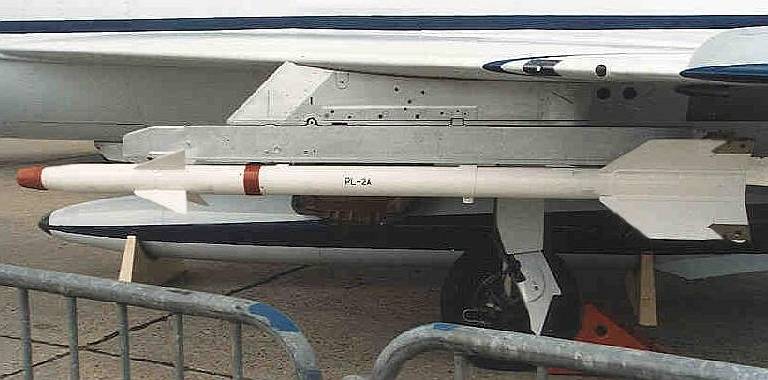
PL-2A missile
In 1982, the PL-5 UR entered service, which also led the pedigree from Sidewinder. But, apparently, this rocket did not live up to expectations, and its release lasted only 5 years.
Due to the obsolescence of the PL-2 and the failure of the PL-5, the PLA leadership decided to acquire a modern melee missile system from the West. After rapprochement with Washington, the Chinese got the opportunity to purchase weapons from US allies as well.
In 1988, at the international arms exhibition, China presented the PL-7 short-range missile with IR seeker, created on the basis of the French R.550 Magic missile. By the time the license for the production of the R.550 Magic was transferred to the PRC, this rocket was no longer new; its serial production in France had been carried out since 1974.
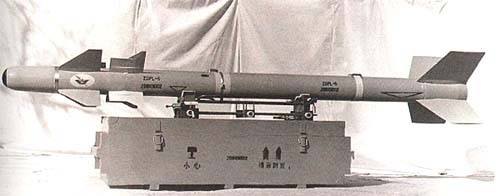
PL-7 rocket
The Chinese UR PL-7 was in no way superior to the French prototype. With a length of 2 mm and a diameter of 750 mm, the starting weight was 178 kg. The maximum launch range is 89 km. Effective - 8 km. PL-3 missiles were equipped with J-7 fighters, J-7 interceptors and Q-8 attack aircraft.
The Chinese decided "not to put all their eggs in one basket" and actively used the opportunity to acquire Western-style guided missiles. In 1988, with the permission of the United States, Israel transferred to the PRC a package of technical documentation, individual components and full-scale samples of Python-3 missiles. The first missiles assembled from Israeli components were delivered to the customer in 1989. In the PLA Air Force, the rocket received the designation PL-8.
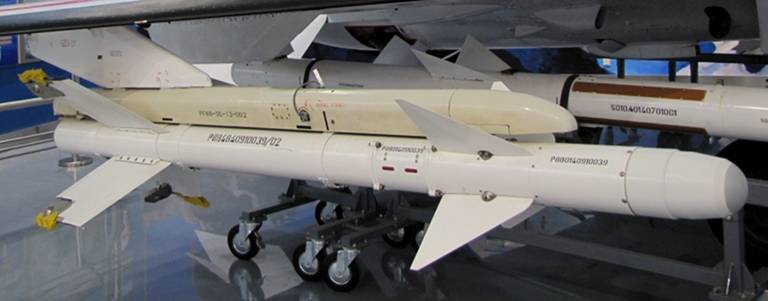
PL-8 rocket
PL-8 is equipped with an IR seeker with an extended field of view, which has good noise immunity. The missile is 2 mm long and 950 mm in diameter. Starting weight - 160 kg. Firing range - up to 115 km, effective against energetically maneuvering targets - up to 20 km. The target is hit by a fragmentation warhead weighing 5 kg; in case of a miss, the warhead is detonated by a proximity fuse.
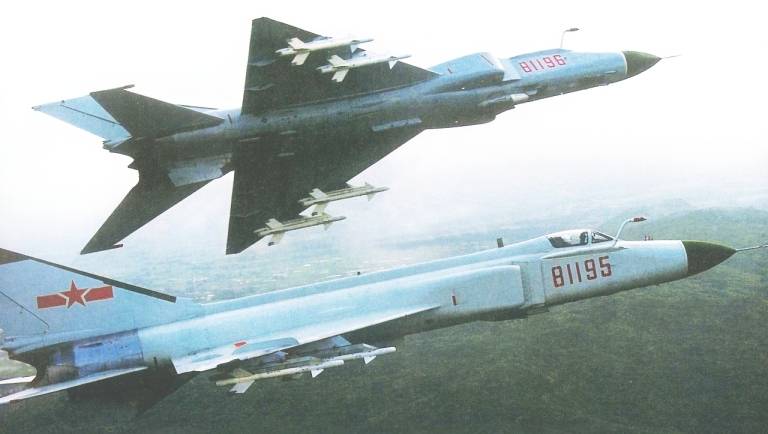
J-8IIF interceptors with PL-8 missiles
On the basis of the PL-8 missile, an improved PL-1990 guided missile was created and put into service in the mid-9s, which has a firing range of up to 25 km and is equipped with a new multispectral seeker.
Equipping Chinese fighters with modern short-range missiles has significantly expanded their capabilities in close combat. But for the armament of fighter-interceptors, which had to operate in any weather and at night, guided missiles were needed, capable of destroying air targets that were not visually observed at long range. Rockets with thermal homing heads were of little use for this, and there was no experience in creating radar homing heads in the PRC.
In the 1970s and 1980s in the West, the most common aviation medium-range missile with semi-active radar guidance was the American AIM-7 Sparrow. China received the first samples of the AIM-7 UR during the years of the Vietnam War. However, due to the weakness of the Chinese radio-electronic industry and the inability to recreate the solid fuel formula, it was not possible to copy this American rocket.
On the basis of the AIM-7E missile in Italy, the Aspide Mk rocket was created. 1 (Aspide-1A), designed for F-104S Starfighter interceptors. The development of the rocket was delayed. Flight tests of the Aspid began in 1974 and lasted until 1986.
Due to the fact that the "Aspid" had higher performance than the American "Sparrow", the Chinese preferred to acquire a license for the production of an Italian product. In China, Aspide Mk. 1, assembled from Italian components, received the designation PL-11.
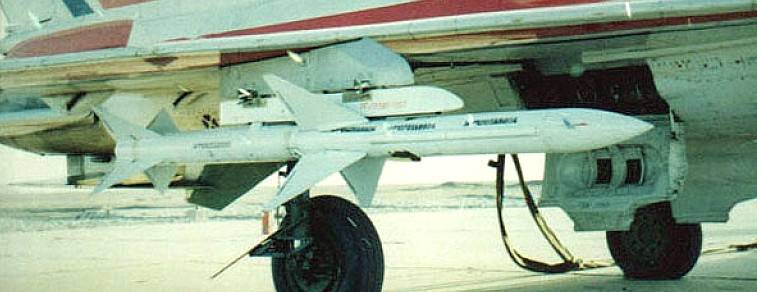
PL-11 rocket
The length of the rocket was 3 mm, diameter - 690 mm, launch weight - 210 kg, fragmentation warhead weight - 230 kg. Firing range - up to 33 km.
After the events in Beijing in June 1989, Italy curtailed military-technical cooperation with China. So far, China has received enough parts to assemble just over 100 missiles. In the early 1990s, the PL-11 UR was introduced into the armament of the combatant J-8-II interceptor fighters.
According to some reports, the PRC managed to launch the production of PL-11A missiles with inertial guidance in the initial and middle sections of the flight and radar illumination only in the final section. English-language sources mention PL-11AMR - this missile allegedly has an active radar seeker, but it is not known whether it has been put into service.
Anti-aircraft missile systems
In the late 1950s, high-altitude reconnaissance aircraft of the American production RB-57D (a copy of the reconnaissance version of the British Canberra), which took off from Taiwan, began to make regular flights over the territory of the PRC. During the first three months of 1959, RB-57Ds made ten many-hour flights over the PRC, and in June of the same year, reconnaissance aircraft flew over Beijing twice. The then Chinese leadership was very sensitive to such a violation of national sovereignty.
In this situation, Mao Zedong made a personal request to Khrushchev to supply China with the latest SA-75 Dvina air defense systems at that time. Despite the beginning of the cooling of relations between China and the Soviet Union, Mao Zedong's request was granted, and in the spring of 1959, in deep secrecy, five SA-75 fire and one technical battalion, including 62 anti-aircraft missiles 11D, were delivered to the PRC. At the same time, a group of Soviet specialists was sent to China to service these missile systems.
Soon, the SA-75 air defense system was used against the violator of Chinese airspace. Under the leadership of Soviet military adviser Colonel Viktor Slyusar, on October 7, 1959, a Taiwanese RB-20D was shot down for the first time near Beijing at an altitude of 600 m. After the explosion of the SAM warhead, the high-altitude reconnaissance aircraft fell apart in the air, and its fragments scattered for several kilometers, and the pilot died.
The Americans, analyzing the loss of the RB-57D, came to the conclusion that it crashed for technical reasons unrelated to the work of Chinese air defense. Reconnaissance flights of high-altitude reconnaissance aircraft continued, resulting in further painful losses. Another 5 U-2 high-altitude reconnaissance aircraft under the control of Taiwanese pilots were shot down over the PRC, some of them survived and were captured. Only after an American U-2 aircraft was hit by a Soviet anti-aircraft missile in the Sverdlovsk region, and this received a great international response, did it come to be understood that high altitude is no longer a guarantee of invulnerability.
The high combat qualities of Soviet missile weapons at that time prompted the Chinese leadership to acquire a license for the production of SA-75 air defense systems (Chinese designation HQ-1). But the intensified Soviet-Chinese disagreements caused the USSR to announce in 1960 the recall of all military advisers from the PRC, and this actually led to the curtailment of military-technical cooperation between the USSR and the PRC.
Under these conditions, further improvement in the PRC of anti-aircraft missile weapons began to be carried out on the basis of the policy of "self-reliance" proclaimed in the country in the early 1960s. However, this policy, which became one of the main postulates of the Cultural Revolution, turned out to be ineffective in relation to the creation of modern types of missile weapons, and it was only in 1 that the HQ-1965 air defense system was launched into mass production. Although this type of air defense system was built in China a little, and their reliability was at a very low level.
In the early 1970s, it became obvious that the Chinese-made HQ-1 complexes did not meet the requirements, and Chinese developers and industry were not able to create anything better. Attempts to steal elements of air defense systems and Soviet-made SA-75M anti-aircraft missiles delivered to Vietnam through Chinese territory did not bring the desired result. The guidance station of this Soviet complex, as in HQ-1, operated in the 10-cm frequency range and did not differ significantly from those available to the Chinese. In general, the USSR, fearing that new Soviet-made systems might end up in China, avoided supplying modern air defense systems to North Vietnam. The same Arabs received much more effective air defense systems.
In 1967, military tests of the HQ-2 air defense system began, but its refinement was very difficult. Although this complex officially entered service in the late 1960s, it was inferior to its Soviet counterparts in terms of its characteristics. The new modification had the same range as the HQ-1, the range of destruction of air targets - 32 km, and the ceiling - 24 m. increased chance of hitting the target.
The HQ-2 anti-aircraft missiles initially differed little from the missiles used in the HQ-1, and generally repeated the Soviet B-750 SAM, but the GJ Sling GJ Sling created in China had significant external and hardware differences from the Soviet prototype CHP-202. Chinese experts used their own element base and changed the location of the antennas. However, fine-tuning the hardware of the guidance station was greatly delayed. At the beginning of 75's, the Chinese radio-electronic industry lagged far behind not only from Western countries, but also from the USSR, which in turn had a negative effect on the noise immunity and reliability of the first stations of the SJ-1970 type.
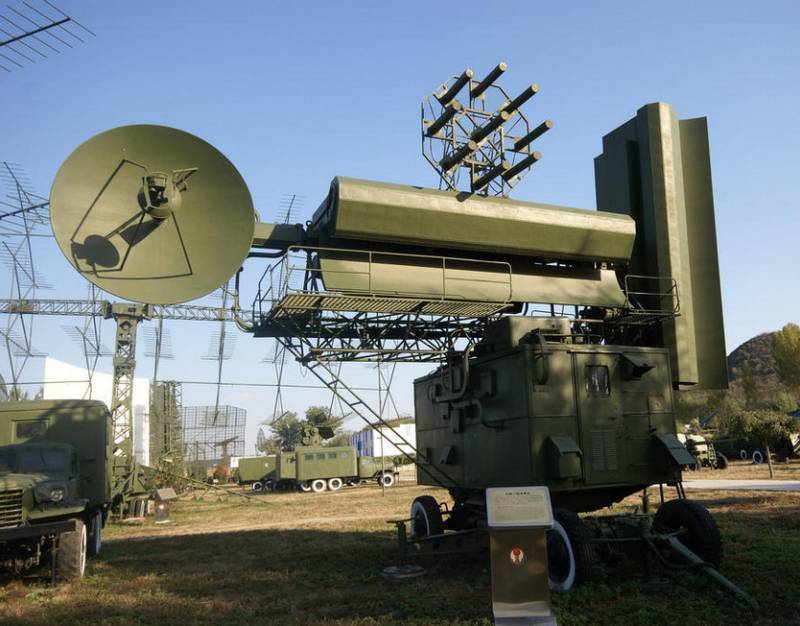
SJ-202 anti-aircraft missile guidance station
According to American data, until the second half of the 1970s, the combat effectiveness of the anti-aircraft missile divisions available in the PLA air defense units was low. Approximately 20-25% of the HQ-2 air defense systems had malfunctions that prevented the combat mission. The low level of training of Chinese crews, the general decline in the culture of production and the technological level that occurred in the PRC after the "cultural revolution" had a negative impact on the combat readiness of the PLA's air defense. In addition, there were very serious problems with the creation of a reserve of anti-aircraft missiles in the troops. The Chinese industry with great effort ensured the supply of the minimum required number of missiles, while the quality of production was very low, and missiles often failed after launch.
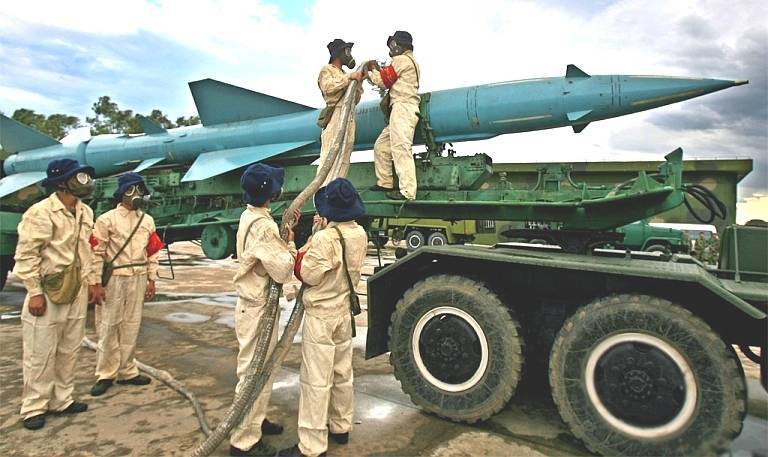
Since missiles often leaked fuel and oxidizer, in order to avoid accidents that could lead to the destruction of expensive equipment and the death of crews, the PLA air defense command issued an order to conduct combat duty with a minimum number of missiles on launchers and carry out their thorough check.
Chinese specialists had an understanding of ways to improve the HQ-2 air defense system, but this required expensive development and development and the development of the electronics industry. It was possible to improve the performance on the HQ-2A modification, which was put into service in 1978.
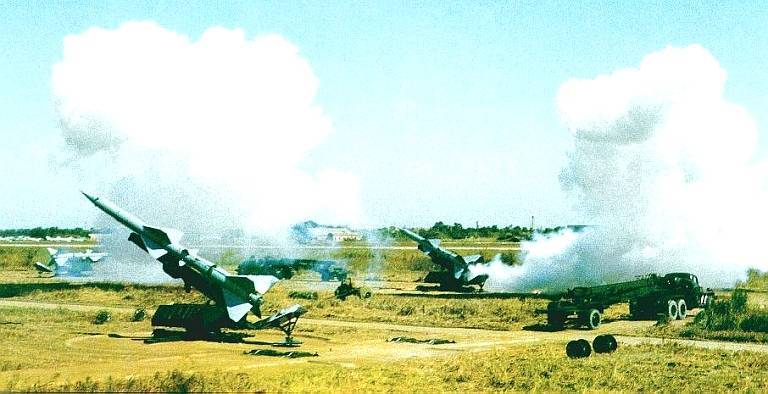
Position SAM HQ-2А
The maximum range of destruction of air targets on this model was 34 km, the altitude was increased to 27 km. The minimum launch range has been reduced from 12 to 8 km. The probability of hitting a non-maneuvering actively subsonic target of the "fighter" type with one missile in a simple jamming environment is about 70%. After bringing to an acceptable level of reliability, the HQ-2 air defense systems formed the basis of the Chinese air defense facility for about 30 years.
Another impetus in the improvement of Chinese HQ-2 air defense systems occurred after rapprochement with the United States, and in 1980, with the permission of Washington, Beijing acquired full-scale samples and documentation for the S-75M Volga air defense system in Egypt. The deal with Egypt provided an opportunity to get acquainted with the original Soviet air defense systems previously unknown to Chinese specialists, which gave a new impetus to the improvement of Chinese anti-aircraft systems. It is worth saying that the export modification of the S-75M Volga air defense system differed from the S-75M Volkhov air defense system only in the systems of state identification and control of the division-regiment-brigade link, but the main characteristics of these complexes were the same.
Until 1973, Egypt was the recipient of modern modifications of the S-75 family at that time. This country received: 32 S-75 Desna air defense systems and 8 S-75M Volga air defense systems (with guidance stations operating in the 6-cm frequency range), as well as more than 2 anti-aircraft missiles (including 700 B -344).
After getting acquainted with the Soviet V-755 (20D) missiles received from Egypt, the new Chinese anti-aircraft missile used improved radio control and radio vision equipment, an autopilot, a radio fuse, a warhead with ready-made striking elements, a liquid-propellant rocket engine of adjustable thrust and a more powerful launch accelerator. At the same time, the mass of the rocket increased to 2 kg. The launch range increased to 330 km and the minimum affected area was 40 km. The new anti-aircraft missiles were used as part of the HQ-7B and HQ-2J mobile air defense systems with the SJ-2 CHP of the 202-cm frequency range, with improved pointing accuracy.
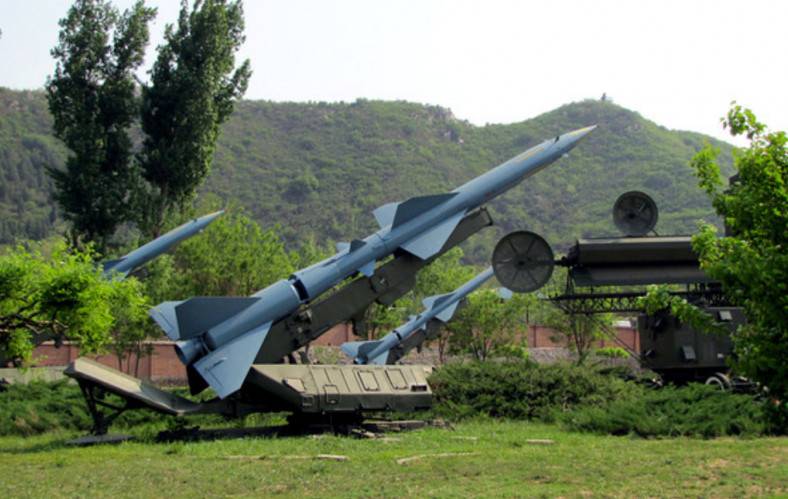
Launchers with missiles and the SJ-202В guidance station at the position of the HQ-2J air defense system
According to advertising brochures presented in the late 1980s at international arms exhibitions, the probability of being hit by one missile in the absence of organized interference for the HQ-2J air defense system is 92%.
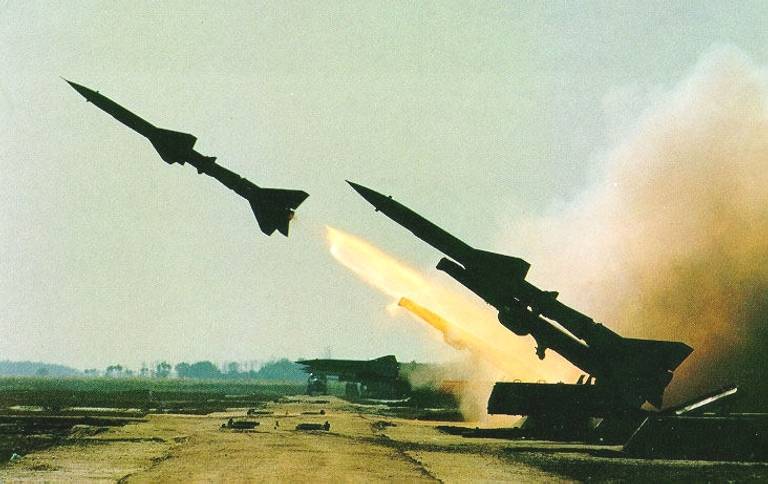
Combat training launch of the HQ-2J air defense missile system at the training ground
Thanks to the introduction of an additional target channel in the CHP SJ-202В in the working sector of the guidance radar, it is possible to simultaneously fire at two targets with guidance of four missiles.
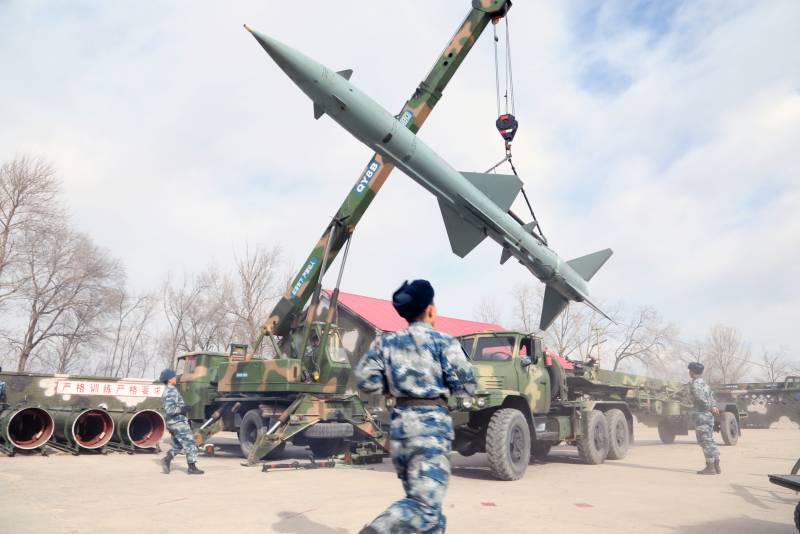
Serial production of the HQ-2J air defense system ended approximately 20 years ago.
As of the mid-1990s, about 80 HQ-2 anti-aircraft missile battalions were deployed in the PRC and about 5 anti-aircraft missiles were produced. The HQ-000 complexes began to be decommissioned in 2, and now there are almost no of them left in service.
Anti-aircraft missile systems of the S-75 family and their Chinese counterparts for the 1960-1980s had a good firing range and, when used as part of a layered air defense system, were of high combat value. However, the capabilities of even the latest modifications of the S-75 air defense system in terms of hitting low-altitude highly maneuverable air targets were limited. Due to the need to refuel rockets with liquid fuel and oxidizer, the operation of the C-75 and HQ-2 caused many difficulties.
In the USSR, this problem was partially solved after the adoption of a very successful low-altitude S-125 air defense system with solid-propellant missiles. In the 1970s, low-altitude S-125s, medium-range S-75 systems and long-range "semi-stationary" S-200s were reduced to mixed anti-aircraft missile brigades and deployed so as to mutually cover each other and overlap the entire range in range and range in the area of responsibility. height.
As you know, the Soviet Union did not transfer the S-125 complexes to the PRC, and they were delivered to North Vietnam by sea at the very end of the war, and therefore Chinese intelligence could not get to them. Apparently, the Americans did not allow Egypt to sell the S-125 air defense system to China, although Beijing received many other Soviet weapons from Cairo.
In connection with the urgent need of anti-aircraft missile forces in a low-altitude facility complex with solid-fuel missiles, in the early 1990s, the HQ-61 air defense system was created in the PRC, for which they adapted missiles designed on the basis of the Italian medium-range aviation missile Aspide Mk. one.
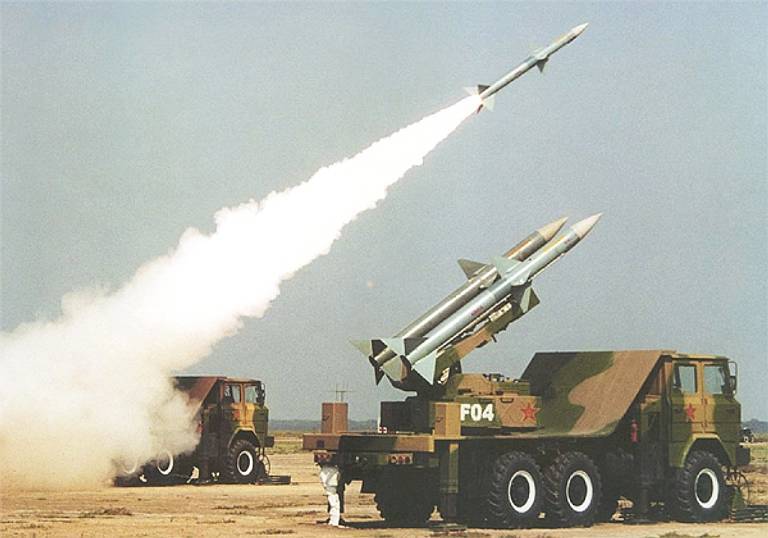
HQ-61 air defense missile launch
When creating the HQ-61 air defense system, Chinese designers largely repeated the path previously taken when creating the Italian Spada air defense system. But the characteristics of the Chinese complex turned out to be more modest: the firing range was up to 10 km, the interception height was from 25 to 8 m. Type 000 all-round radar was used to detect air targets, a very simple station with a parabolic antenna and television - optical sight. On a mobile launcher, made on the basis of a three-axle off-road truck, there were two missiles ready for use. The anti-aircraft division included: five SPUs, a detection radar, a guidance station and vans with diesel power generators.
Already at the time of the creation of the HQ-61 air defense system did not meet modern requirements and had low operational reliability. He could only operate in a relatively simple jamming environment and in conditions of good visual visibility. In this regard, this complex was produced in small quantities and was in trial operation.
After the Chinese industry managed to master the independent production of a clone of the Italian Aspid in the second half of the 1990s, a missile was created for use as part of the air defense system, which received the designation LY-60.
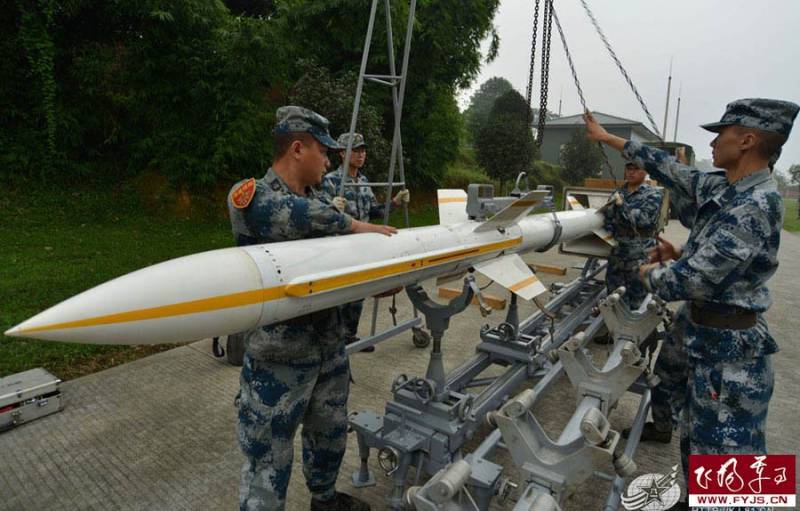
PLA soldiers with a LY-60 missile
The LY-60 anti-aircraft missile has a launch weight of 220 kg, when launched from a ground launcher, it is capable of hitting air targets at a distance of up to 15 km. Currently, this missile is used in the HQ-64, HQ-6D and HQ-6A mobile complexes. Unlike the HQ-61 air defense system, on the HQ-64, which was put into service in 2001, the missiles are in closed transport and launch containers. At the same time, the number of ready-to-use missiles on the self-propelled launcher has been increased from two to four.
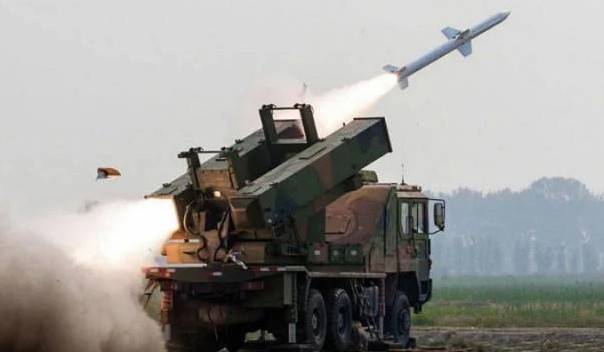
Rocket launch from a mobile launcher SAM HQ-64
It is reported that modernized versions of anti-aircraft missiles with an active radar seeker are currently being used, which makes it possible to implement the “fire and forget” mode. Thanks to the introduction of more energy-intensive solid fuel, the maximum speed of missiles has been increased from 1 to 200 m/s, and the launch range has also increased to 1 km. Increased hardware reliability and radar detection range. The HQ-350D air defense system has the ability to integrate the HQ-18 long-range air defense system into the control system and, thanks to the introduction of new microprocessors, the information processing speed and the number of target channels have been increased. New missiles have been introduced into the ammunition load. According to reference data, at least 6 HQ-9D / 20A air defense systems are on combat duty as part of the PRC air defense system.
In 1989, at the aerospace show in Dubai, the HQ-7 short-range air defense system was demonstrated for the first time. This complex was created within the framework of the Sino-French defense cooperation based on the Crotale mobile air defense system.
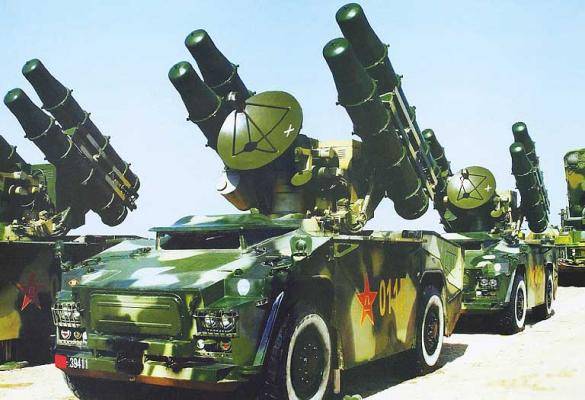
Combat vehicles SAM HQ-7
The HQ-7 air defense battery includes a combat control vehicle with a radar for detecting air targets (range 18 km) and three armored combat vehicles with radio command guidance stations, each combat vehicle has four TPKs with ready-to-use missiles. Missile guidance is radio command, each launcher can fire only one target with two missiles. The SAM is made according to the "duck" aerodynamic scheme, equipped with a solid-fuel engine and is identical in design to the French Crotale rocket.
The upgraded HQ-7B air defense system uses a battery command post equipped with a radar with a phased array (detection range of 25 km), and the maximum launch range has been increased to 12 km. At the same time, noise immunity and the probability of damage are significantly increased. The complex supplied to foreign customers has the designation FM-90.
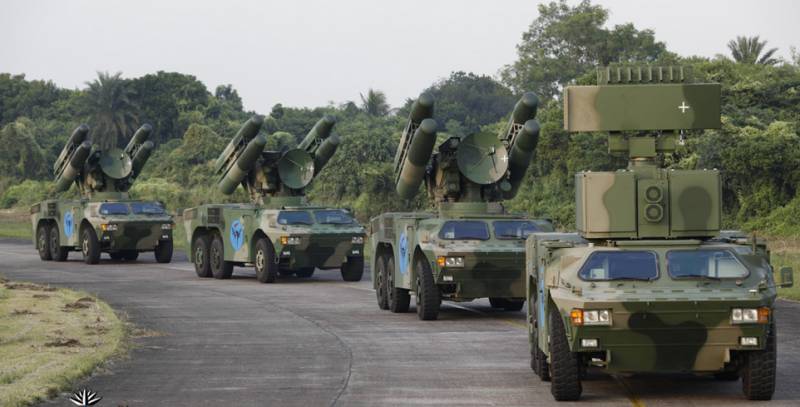
Battery SAM FM-90 Bangladesh Armed Forces
In terms of its capabilities, the HQ-7В (FM-90) air defense system is comparable to the Soviet Osa-AKM. The upgraded anti-aircraft missile weighs about 90 kg and has a length of about 3 m, a body diameter of 156 mm, and a maximum flight speed of 750 m/s. The maximum firing range is 12 km. Ceiling - 6 km. According to Chinese data, in a simple jamming environment at a range of 9 km, the probability of destroying a MiG-21 type target flying at a speed of 900 km/h with a two-missile salvo is 0,95.
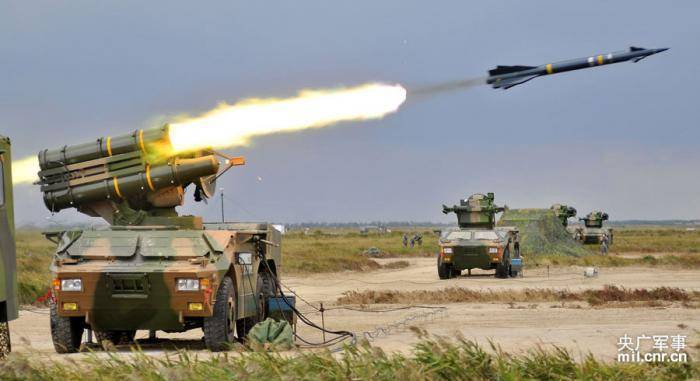
The HQ-7 / 7B air defense systems are in service with the air defense units of the ground forces and are used by the Air Force to protect airfields. Anti-aircraft missile systems of this type covered large air bases located along the Taiwan Strait. For combat duty for the protection of stationary objects, one of the three fire batteries was usually allocated on a rotational basis from the composition of the anti-aircraft missile division. The duration of duty of one battery usually did not exceed 15 days.
To be continued ...
Information